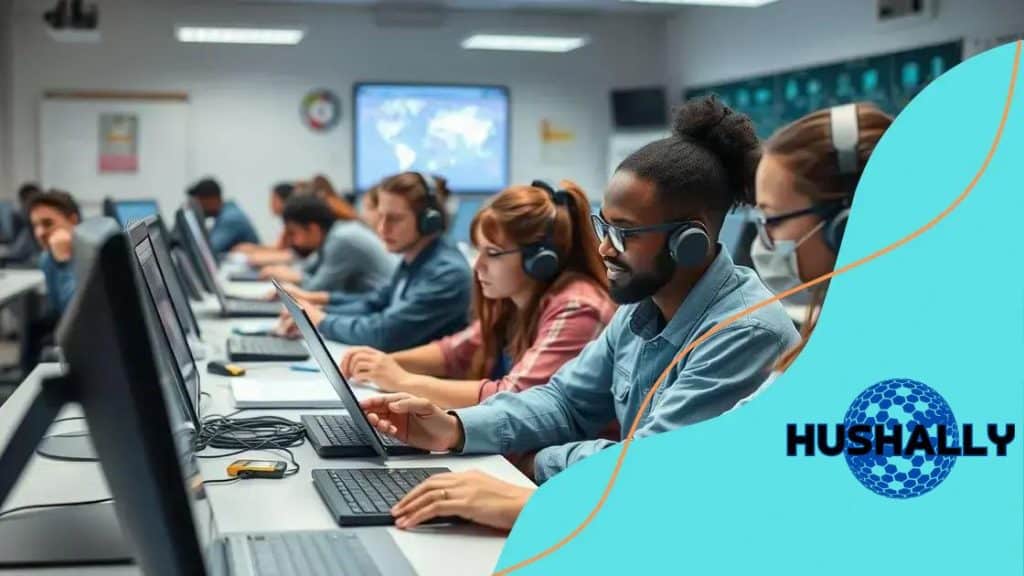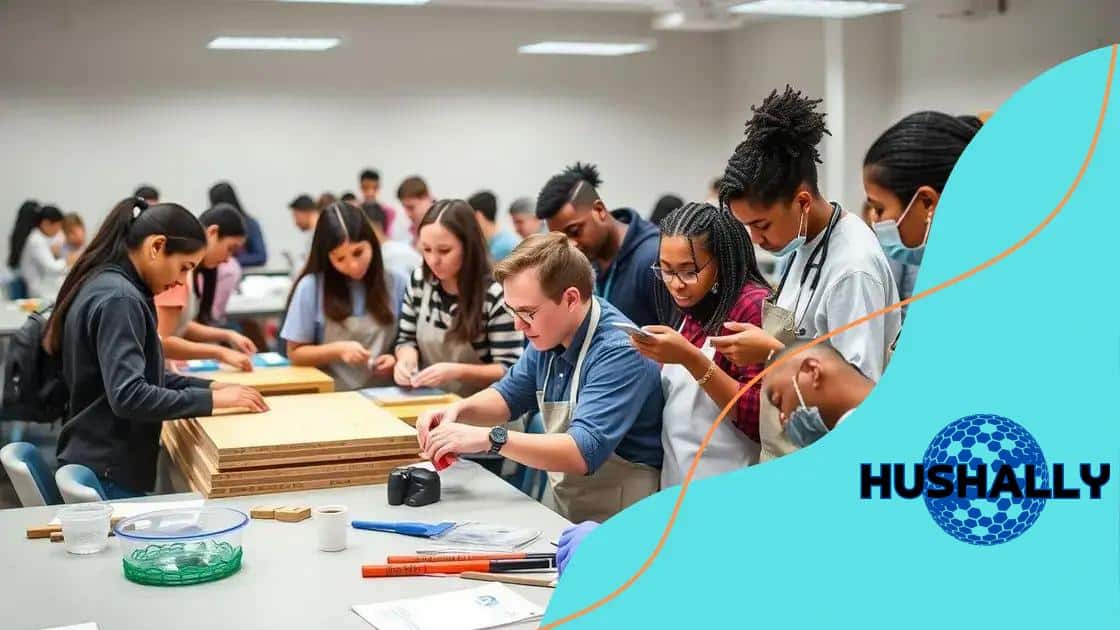Vocational programs adapting to AI: is your future ready?

Vocational programs adapting to AI are transforming education by integrating technology, emphasizing soft skills, and offering personalized learning paths to prepare students for a dynamic workforce.
Vocational programs adapting to AI are transforming the landscape of professional training. Have you considered how these shifts might influence your career path? Let’s dive into the changes shaping the future.
Understanding vocational programs
Understanding vocational programs is crucial for those looking to enhance their skills and improve their job prospects. These programs are designed to prepare students for specific careers, offering hands-on training and specialized education. Let’s explore what makes these programs unique and beneficial.
The Purpose of Vocational Programs
Vocational programs aim to equip students with the necessary skills to enter the workforce quickly. Unlike traditional degree programs, these courses focus on practical knowledge and experience. They often combine classroom instruction with real-world applications.
- Emphasis on hands-on training
- Shorter duration compared to traditional degrees
- Direct pathways to employment
Types of Vocational Programs
There are various types of vocational programs available, catering to different industries. These programs can be found at community colleges, technical schools, and through apprenticeships.
- Healthcare training (nursing, medical assisting)
- Technical skills (plumbing, electrical work)
- Art and design (culinary arts, graphic design)
Moreover, some vocational programs offer certifications, enhancing a graduate’s employability. It’s essential to choose a program that aligns with your career goals and interests.
Many students benefit from the supportive environment these programs provide. Instructors often have industry experience, offering insights and mentorship to students. This real-world knowledge can be invaluable in preparing for a successful career.
Why Choose a Vocational Program?
Choosing a vocational program can lead to significant advantages, such as:
- Lower education costs compared to traditional colleges
- Quick entry into the workforce
- Specialized training tailored to market demands
These factors make vocational programs a wise choice for many individuals. The focus on gaining practical skills helps students feel more prepared and confident.
The role of AI in education
The role of AI in education is evolving rapidly, impacting how students learn and teachers instruct. By incorporating artificial intelligence, educational institutions are transforming traditional learning methods into more interactive and personalized experiences.
Personalized Learning Experiences
One significant advantage of AI in education is its ability to deliver personalized learning. Students can learn at their own pace, receive tailored feedback, and access resources that suit their individual needs. This approach helps them grasp concepts more effectively and enhances overall learning outcomes.
- Adaptive learning platforms adjust material based on student performance.
- AI tutors provide instant support outside classroom hours.
- Personalized quizzes and assignments target areas for improvement.
Data-Driven Insights
AI also generates valuable data that educators can use to enhance teaching strategies. By analyzing student performance and behavior, teachers can identify trends and implement changes to improve learning environments. This data-driven approach empowers educators to make informed decisions about their teaching methods.
Many schools and universities utilize AI tools that help in tracking academic progress, evaluating engagement levels, and understanding student needs. This leads to more effective intervention strategies when students struggle or excel.
Streamlining Administrative Tasks
AI can alleviate administrative burdens for teachers, allowing them to focus more on instruction. Tasks such as grading assignments and scheduling can be automated, saving time and reducing stress.
- Automated grading systems increase efficiency.
- AI scheduling tools optimize class timetables.
- Resource management software helps balance workloads.
By automating these processes, educators can dedicate more time to student interaction and enriching the classroom experience. The integration of AI into education signifies a major shift toward a more efficient and engaging learning environment.
Benefits for students and the workforce

The benefits of vocational programs for students and the workforce are significant and far-reaching. These programs play a vital role in preparing individuals for successful careers while meeting the demands of the job market.
Skill Development
One of the main advantages of vocational programs is that they focus on practical skill development. Students gain hands-on experience in various fields, making them more prepared for their future jobs. By learning specific skills, they can easily transition from the classroom to the workforce.
- Hands-on training enhances understanding of job requirements.
- Real-world simulations build confidence in using tools and methods.
- Certification programs demonstrate proficiency to employers.
Vocational programs also help in fostering soft skills such as teamwork, communication, and problem-solving. These skills are essential in almost every job, making graduates more attractive to employers.
Increased Employment Opportunities
Another important benefit is the increased employment opportunities for graduates. The job market often seeks skilled workers who can meet specific needs. Vocational programs align with these demands, providing students with relevant training.
- Strong industry connections enhance job placement rates.
- Employers value candidates with practical experience.
- Internships and apprenticeships provide direct pathways to employment.
The ability to quickly enter the workforce is a significant advantage for students. They can often find jobs that match their training soon after graduation, reducing unemployment rates among young adults.
Meeting Industry Demands
Vocational programs also serve an essential role in meeting the evolving demands of industries. As technology advances, many sectors require skilled professionals who are trained in the latest practices and technologies. These programs continuously update their curricula to reflect current industry standards, ensuring graduates are job-ready.
The workforce benefits from this alignment as employers gain access to a pool of skilled candidates who can contribute to their companies right away. This streamlining helps drive innovation and productivity, impacting overall economic growth positively.
How institutions are adapting
Many institutions are adapting to the growing influence of artificial intelligence within educational frameworks. Schools and colleges are re-evaluating their teaching methods to incorporate new technologies that enhance the learning experience.
Integrating Technology in the Classroom
One primary adaptation is the integration of technology into the classroom. Educators are using AI tools to create more engaging and personalized learning environments. These tools help educators track student progress and provide tailored resources.
- Interactive learning platforms motivate students.
- Smart content adapts to the needs of each learner.
- AI-assisted grading systems free up teacher time.
With these advancements, teachers can better focus on instruction and provide individual support to students who may need extra help.
Training Educators
Institutions are also investing in the professional development of their educators. Training programs are essential for teachers to understand how to effectively implement AI in education. These programs enable educators to use AI-driven tools effectively in their teaching practices.
Workshops and seminars focusing on new technologies help teachers stay updated on trends. This professional development is crucial for ensuring that instructors can utilize AI tools to enhance student learning.
Collaboration with Industry
Another way institutions are adapting includes collaborating with technology companies and industry leaders. By partnering with these organizations, schools can access the latest innovations and resources to improve their educational offerings.
- Access to cutting-edge AI tools and platforms.
- Internship programs offered through industry partnerships.
- Curriculum development aligned with workforce needs.
Through these collaborations, schools can ensure their programs remain relevant and prepare students for employment in a tech-driven job market.
Future trends in vocational training
The future trends in vocational training are expected to transform how individuals acquire skills for their careers. As industries evolve and technology advances, vocational education must adapt to meet these new demands.
Incorporating Technology
One significant trend is the increasing use of technology in vocational training. Virtual reality (VR) and augmented reality (AR) are becoming common tools in various fields, allowing students to experience realistic job scenarios without the associated risks. These immersive technologies enhance practical learning by simulating real-world environments.
- VR training for high-risk jobs, such as aviation and healthcare.
- AR tools for hands-on skills, like plumbing or electrical work.
- Online platforms for flexible learning opportunities.
As technology integrates further into these programs, students can gain experience that closely mirrors what they will encounter in their actual jobs.
Focus on Soft Skills
In addition to technical skills, there is a growing emphasis on soft skills within vocational training. Employers increasingly seek candidates with strong communication, teamwork, and problem-solving abilities. Training programs are starting to incorporate these essential skills into their curricula to ensure graduates are well-rounded.
Workshops and collaborative projects enhance soft skill development. This focus creates a more effective workforce, capable of adjusting to various work scenarios and challenges.
Personalized Learning Paths
Another emerging trend is the move toward personalized learning paths in vocational education. Institutions are utilizing data-driven approaches to tailor training based on individual student needs and career goals. This customization helps enhance learning outcomes and engagement.
- Adaptive learning technologies adjust content according to student progress.
- Individualized support from instructors helps guide students.
- Flexibility allows learners to progress at their own pace.
This shift toward personalized education ensures that students receive the training and support they need to succeed in their chosen fields.
FAQ – Frequently Asked Questions about Vocational Programs and AI
How are vocational programs incorporating technology?
Vocational programs are using technologies like VR and AR to provide realistic training experiences, enhancing skill development and engagement.
What skills are emphasized in modern vocational training?
In addition to technical skills, modern vocational training focuses on soft skills such as communication, teamwork, and problem-solving.
What are personalized learning paths?
Personalized learning paths tailor education to individual student needs, allowing for customized support and pacing during the training process.
How do industry partnerships enhance vocational training?
Industry partnerships provide access to the latest technologies and resources, ensuring that the training is relevant and aligns with job market demands.





